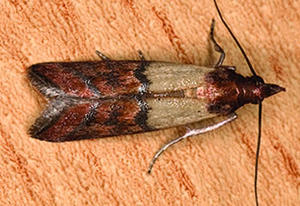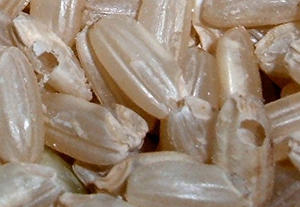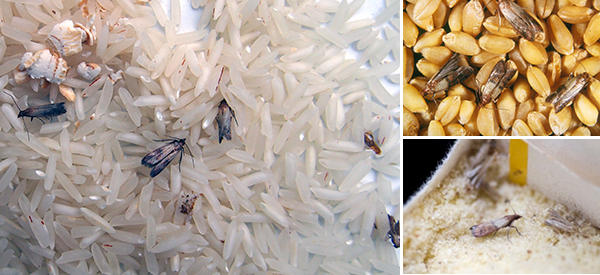A moth can wreak havoc on about anything. Have you ever noticed an infestation in your grains? They are notorious for laying eggs in your flour and rice. They will also invade your grain bins and silos where you store your freshly harvested products.
Moths that feed on your grains are the Indian Meal Moth. This moth is also known as the grain moth, flour moth, weevil moth, and pantry moth. It is the most common species, that will infest your stored grains.
Moth Life Cycle
 The life cycle of a moth is about 30 to 35 Days. This is from the time the egg is laid and the moth dies. Due to the short lifespan of a moth, it is difficult to get an infestation under control because there is always a next generation started.
The life cycle of a moth is about 30 to 35 Days. This is from the time the egg is laid and the moth dies. Due to the short lifespan of a moth, it is difficult to get an infestation under control because there is always a next generation started.
A female moth will lay an average of 150 eggs but can lay up to 300 eggs in her life. The eggs will hatch in about a week’s time. These eggs are grayish white in color and are very small. You usually don’t notice the eggs when they are in your grains, what you will notice is the larvae.
The larvae are internal borers in the grain, feeding on the starchy part. The larval stage is about three weeks. The caterpillar is yellowish white in color with a brown head. The larvae hatch and soon bore into the grain and start to feed. Before pupation the larva will construct a silk cocoon in the hole made in the grain from feeding. The pupa is reddish brown in color.
The pupa emerges from the cocoon in four to seven days. The adult is a small, straw colored moth. Adults are short lived. They can be seen flying around in large numbers in storage bags and on grain surfaces.
Related: 10 Bugs You Should Never Kill In Your Garden
Signs Of Infestation
 Grains that are infected are often covered with scales shed by the moths. The grains are left hollow and are filled with larval feces. Infected grains are unfit for consumption and often smell bad. You will need to discard of any infected grains. The larvae can eat through plastic and cardboard so even unopened containers can become infected.
Grains that are infected are often covered with scales shed by the moths. The grains are left hollow and are filled with larval feces. Infected grains are unfit for consumption and often smell bad. You will need to discard of any infected grains. The larvae can eat through plastic and cardboard so even unopened containers can become infected.
It is very hard to check if there is an infestation with the naked eye in the egg stage. You will need a magnifying glass to see. Aside from catching the infestation so late and seeing moths flying around there are other things you can do. Inspect with a flashlight being sure to look in the corners and crevices of the entire area. Also, be sure to inspect the food or grain product itself with a light.
Seeing clumps in the infested food is a sign that you have a problem. You can also see the larvae crawling around, especially as they grow because they become bigger. Another sure sign is actually seeing the moths flying in your grain storage or in your kitchen. The moths fly mostly at night and are attracted to light sources.
If you are unsure of an infestation you can test it. Place the grains in a clear plastic bag where you will be able to see inside. If you notice that there is an infestation you need to discard of the product. It is a good idea to store the item in the bag for a month to be sure that it is pest free. If you do not see any signs in the months time then you are good to go.
Related: How to Get Rid of Bedbugs Using Household Items
Prevention And Management
Storage is key when it come to deterring moth infestation. There are several different options from natural remedies to insecticides to help control and rid a grain moth infestation.
#1. Good Hygiene
Thoroughly clean all bins and containers with white vinegar and allow them to completely dry before use. Do not mix the old and new foods together, if the old food is infested then the moth can invade the new food. Wipe down all shelving, being certain to remove any food bits that may attract a moth. Also, be sure to clean aeration ducts, augers, elevators and harvesting equipment before and after each use to prevent cross contamination. For extra precautions you can also use a few drops of essential oils such as peppermint, tea tree, eucalyptus, and citronella.
#2. Weatherproofing
It is best to repair and seal any cracks or holes in your storage area. You do not want to allow moisture to enter. Apply insecticides to your aeration ducts to prevent entry.
#3. Insecticides
If storing in jute bags it is recommended that the bags be dipped in insecticidal solution of fenitrothion and water according to instructions. You can also spray the stored bags with an application of dichlorvos, being sure to follow the instructions for use.
#4. Traps
You can use sticky traps or cardboard traps that are baited with the female moth sex pheromone to catch the male moth. Hang these traps anywhere needed.
#5. Storage Practice
Do not overfill your grain bins. You should leave at least six inches of space between the grain and the top. Be sure to level the grain. If the grain is stored hooved then it is easier to penetrate. It is also a good idea to store foods in tightly sealed containers out of their original package. Do not purchase damaged packages as they can be infested and you will bring them into your home.
#6. Temperature Control
Entomologist, Harold Shepard, discovered in 1947 that insect activity is slight at 45 degrees Fahrenheit and no insect activity at temperatures at 43 degrees Fahrenheit. It is best to maintain a temperature between 40 to 43 degrees Fahrenheit. It is a good idea to store dry goods in the freezer for one week to kill off any eggs that may be present. If you have space then you can store there long term.
#7. Moisture
Grain moths prefer moisture so it is best to keep the grains and storage dry. You can dry freshly harvested grains in the sun for about three days to reduce the moisture content. The recommended moisture content is below 12%. The moisture is maintained by air flow in your storage.
#8. Bay Leaves
Grain moths do not like the bay leaf. To repel the moth place the leaves in containers and in bins or cupboards.
#9. Lemon Peels
The grain moth does not like lemon. You can lay lemon peels about on your shelves of the pantry or cabinets.
#10.Vacuum
If you do notice any of the larvae or moth’s then you can vacuum them up. Be sure to vacuum up the whole area and any contents that may be spilled. Empty the vacuum outside or take the bag and discard of it outside of the home to prevent any further infestation.
Low temperatures and low moisture levels can allow grains to be safely stored for months. There are certain items that a moth don’t particularly care for and the presence will deter them from invading. It is always a good idea to take extra precautions to prevent an infestation.
Grain moths can produce several generations in a year’s time. Being diligent in checking your grains is the best way to keep the infestation from spreading. Always use your older grains before opening any new packages and be sure to clean the containers. Good hygiene and storage are the most important when dealing with the dreaded grain moth.
You may also like:
 The Top 10 Cereal Grains You Need To Have in a Crisis
The Top 10 Cereal Grains You Need To Have in a Crisis
Do You Make These Fatal Mistakes In A Crisis? (Video)
Get An Unlimited Supply Of Beans Growing This Tree
Bean and Rice Survival Soup, Easy and Adaptable Recipe
How To Store Six Months of Food When You Only Have Space for One















At the family farm, they have used mint and fresh slabs of cedar thrown into the grain as well as the fly traps.
On the theory they cannot live without air, I vacuum bagged beans and rice. After two years there is no sign of
larva or any life, even though we have noticed moths flying
around, probably invading the parrot’s dropped food.
As DannoBoone above said I, too, will vacuum pack beans and rice. Also I put some in large, food-grade containers with a dessicant, an oxygen absorber and a few bay leaves.I also use Gorilla tape around the cap. About 15 years ago I bought a bay leaf tree/bush seedling and now I have a huge bush. I dehydrate leaves all the time for self use and to give to friends.
If you read the Book of Jasher, it tells of Joseph, son of patriarch, Jacob, when storing up food for the coming famine in Eqypt, buried the grain to protect against vermin and then uncovered it as needed during the famine It says that the Pharoah’s dream and Joseph’s interpretation of the coming famine was made known among the populace and they also stored their own grains individually, but they did not follow Joseph’s example of burying the grains and when famine came, they populace found that their own grains had been infected or devoured by vermin or insects and they were dependent on the food stored by Joseph..
About 10 years ago, I got an infestation of Indian meal moths. It happened 2 years in a row, during late summer. They got into everything – pastas, cereals, flours, rice, even paprika! Right through boxes, plastic cellophane, etc. They leave behind silk webs like spider webs, plus make cocoons in hidden cabinet corners, or up where your wall meets the ceiling. I’m a prepper, so lost over $100 worth of supplies. Plus so much work emptying & washing every inch of kitchen, cabinets, basement stockroom, and even our garage where they got into deer feed & bird seed!
They CANNOT get into glass jars with tightened lids, or heavy plastic jars with tight threaded lids. Also, freezing kills eggs; put newly bought grain based foods into freezer for a few days before shelving in pantry or stockroom.
I checked the grocery store where I had bought some of the products, trying to figure out how I got them; The moths were flying around above the pasta shelves area, so I alerted the store about their infestation. That’s where I got them from.
When I worked at a bakery it wasn’t unusual to receive flour and other products already infested with various critters. A hard freeze or vacuum packing are good ideas, and just constantly checking stored food for quality. The critters don’t seem to eat much and I have accidentally baked them into bread and eaten them and continue to thrive. It reminds me of Melville describing the molded bread they had to eat on a whaling ship as their principle anti-scorbutic. Or N. Chagnon detailing the preparation and sharing of fried Rhino Grubs with the Tribal Peoples in Amazonia. Squiggly things is good when you’re really really hungry.
I have read accounts of prisoners of the Japanese during WWII and also the Germans and they were please to see the remains of various insects in their gruel because it meant that they were getting at least a small portion of protein which their diets lacked on a daily basis. Only fools picked the critters out of their gruel.
Also read accounts of 18th and 19th century sailors and maggots in their bread which they also ate for the protein. Not happily, but it was just a fact of life. If you lived in the foc’sal you got grubby biscuits after so many weeks at sea.
IvyMike: You and I seem to have led similar lives. I also worked in a bakery for about month scraping crud off of everything in the back room of the bakery with a putty knife. Their reputation for having the best baked goods in the area would have gone down the drain if folks could have seen where everything was prepared.
Dried hot peppers also repel insects!
They actually can get into glass jars. I had to start vacuum sealing my jars to keep them out.
I always freeze grains and pasta if its being stored. Storage on shelves has always been in glass with bay leaves in every container.
Learned this the hard way years ago.
Freezing is good, also garlic glove will keep them away
My wife and I heard long ago about the efficacy of using bay leaves.
Using whole bay leaves, we would put about 6 or so at the bottom of our flour containers, and then the same for every 8-10 inches of flour to lay another layer of leaves. Easy to pick the leaves out when using, never in all the time of using them did we ever have any bugs in our flour………………………Nemo
I haven’t seen many of the moths, fortunately, but I’ve had problems with little dark brown critters that look similar to tiny ants. What are those?
I’m certainly no entomologist, but sorta sounds like weevils. A Google search revealed that there are 97,000 different kinds of weevils. They come in all kinds of sizes and shapes.
I thought diatomaceous earth was the answer to all insect problems
Spike, DE will kill insects but it will not keep them away. Mix some DE in with your grains and the insects may still hatch and the larva will die; just a little extra protein. DE will not repel moths or other insects. I think bay leaves will repel insects. I still use DE but I only sprinkle it around the containers of dry goods. If you use DE be sure it is food grade.
Thanks for the information. You guys are probably one of the best sources of info on survival I think that exists. Keep up the good Work
My experience is that a lot of insect infestation comes in the item as bought. the eggs/larve/ etc are already there, prepackaged. To salvage infested items and to kill them is easy and not very costly. Place the grain in Non ferrous/non metallic container, if need be put plastic wrap over mouths of container. Next microwave the item. The time will depend on the container and the volume inside of the container. If there is moisture it will need a way to vent while in microwave. it may be a good idea to rotate the container to stir up contents and microwave again. living organisms will be killed by the microwaves.The idea is not to cook the food ,but to destroy by microwaves the contamination. a little experimentation will be needed–again not long enough to cook, brown, pop, the flour or grain. Infested grain can be sifted to remove dead insect bodies. After the microwave treatment, then do your storage in a rodent, bug proof container. Doing this will ensure what you are storing is not infected with bugs. A simple added step, but one that can prevent unwanted pests.
Also spearmint gum will repl bugs